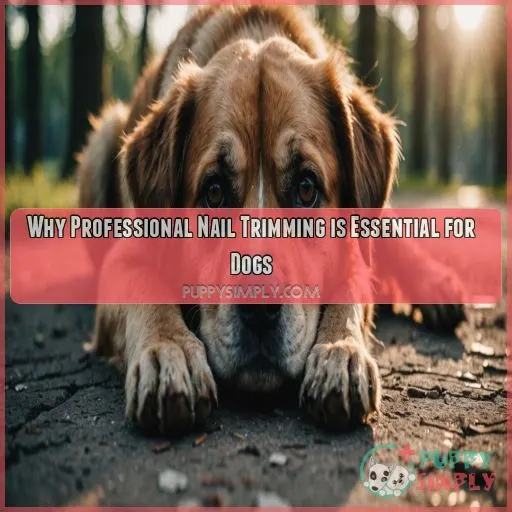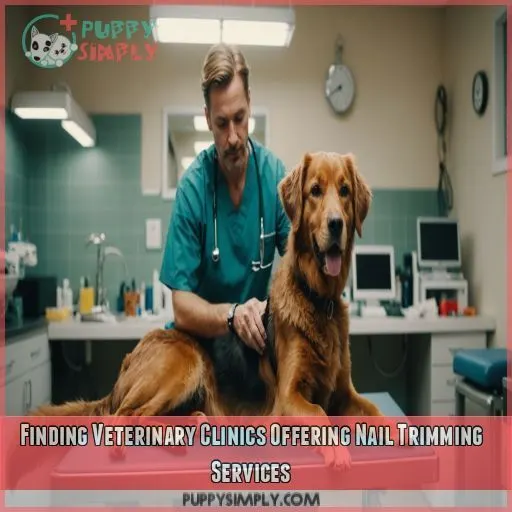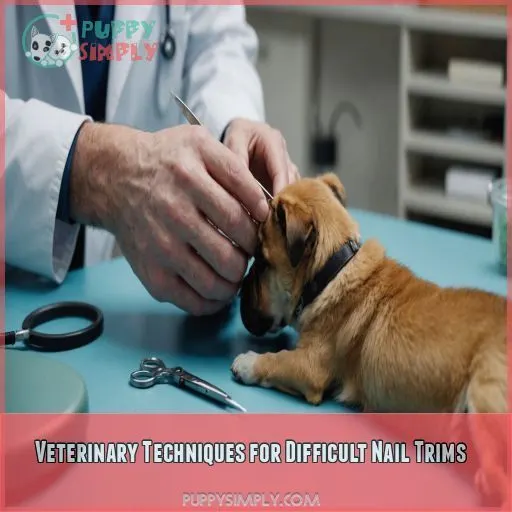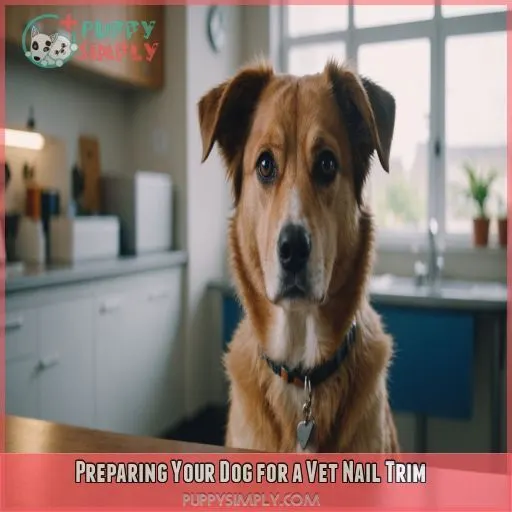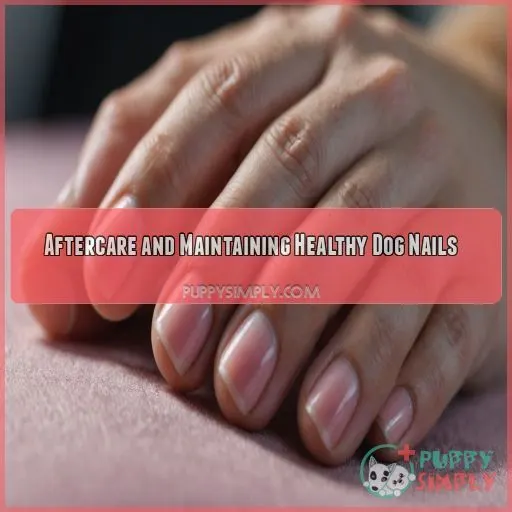This site is supported by our readers. We may earn a commission, at no cost to you, if you purchase through links.
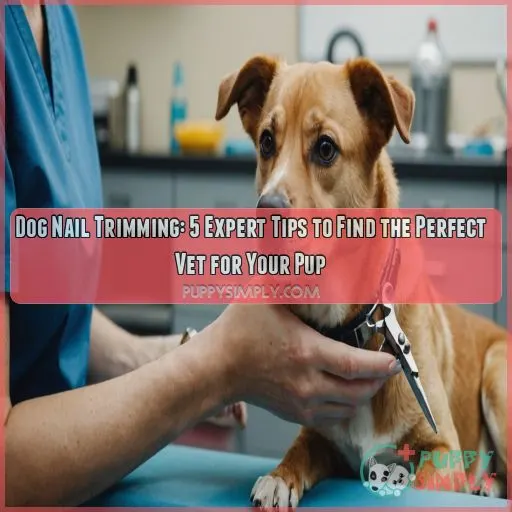 Trimming your dog’s nails – the ultimate test of trust and sanity! But seriously, finding the right vet to do it can be a challenging task.
Trimming your dog’s nails – the ultimate test of trust and sanity! But seriously, finding the right vet to do it can be a challenging task.
To start, research local veterinary practices that offer nail trimming services. Ask fellow pet owners for recommendations, and check online reviews to guarantee you’re getting a skilled and gentle pro.
You want someone who’ll keep your pup’s paws healthy and pain-free. With a little legwork, you’ll find a vet who’ll make nail trimming a breeze.
And that’s just the beginning – stay tuned for expert tips on how to make nail trims a stress-free experience for both you and your furry friend!
Table Of Contents
- Key Takeaways
- Why Professional Nail Trimming is Essential for Dogs
- Finding Veterinary Clinics Offering Nail Trimming Services
- Veterinary Techniques for Difficult Nail Trims
- Preparing Your Dog for a Vet Nail Trim
- Aftercare and Maintaining Healthy Dog Nails
- Frequently Asked Questions (FAQs)
- Can I take my dog to the vet for nail trimming?
- How do vets cut a dog’s nails that won’t let you?
- Will a vet sedate a dog to trim nails?
- How much does it cost to cut a dog’s claws?
- How do vets sedate dogs for nail trimming procedures?
- Can dogs be hurt during nail trimming at the vet?
- What are the benefits of mobile nail trimming services?
- How do vets handle dogs with anxiety during nail trims?
- What is the average cost of vet nail trimming services?
- Conclusion
Key Takeaways
- When searching for a vet to trim your dog’s nails, don’t be afraid to ask fellow pet owners for recommendations – after all, word-of-mouth is a powerful tool. You can also check online reviews and directories, such as the American Animal Hospital Association’s (AAHA) vet finder, to get a sense of a vet’s reputation and quality of care.
- Before booking an appointment, make sure to contact the clinic and ask about their nail trimming services, including their approach to handling anxious or aggressive dogs. You want to ensure they have the expertise to make the experience as stress-free as possible for both you and your furry friend.
- A good vet will take the time to explain their approach to nail trimming, including any sedation options or specialized restraint methods they may use. Don’t hesitate to ask questions or seek a second opinion if you’re unsure about their approach.
- By doing your research and finding a vet who’s a pro at dog nail trimming, you’ll be able to breathe a sigh of relief knowing your pup’s paws are in good hands. With regular trims, With regular trims, you can help prevent health issues like joint problems and pain, mobility problems, and chronic pain.
, mobility problems, and chronic pain.
Why Professional Nail Trimming is Essential for Dogs
If you’ve ever wrestled with your pup during a nail-trimming session, you know it can be a real challenge. Professional nail trimming isn’t just about convenience – Professional nail trimming isn’t just about convenience it’s essential for your dog’s health and well-being, especially if they’ve behavioral issues or overgrown nails, just like monitoring for adverse reactions to treats
, especially if they’ve behavioral issues or overgrown nails.
Health Risks of Overgrown Nails
Your pup’s overgrown nails are more than just a cosmetic issue. They’re a ticking time bomb for your furry friend’s underlying health issues.
. Neglecting those claws can lead to a host of problems:
- Joint stress from altered walking patterns
- Mobility issues, especially in older dogs
- Increased risk of nail bed infections
- Posture problems affecting overall body alignment
- Chronic pain that may go unnoticed
Don’t let your pooch suffer in silence. Regular trims by a pro can keep those paws happy and healthy!
Benefits of Regular Nail Maintenance
Regular nail maintenance isn’t just a beauty treatment for your pup—it’s a health necessity. Keeping those claws in check offers a host of benefits that’ll have your furry friend wagging their tail with joy.
. Let’s take a look at why professional nail trimming is a game-changer:
| Benefit | What it Means | Why it Matters |
|---|---|---|
| Improved mobility | Easier walking and running | Happy, active pup |
| Pain prevention | No pressure on toes and joints | Comfy, pain-free pooch |
| Infection reduction | Less risk of nail bed issues | Healthier, happier dog |
Challenges of At-home Nail Trimming
While regular nail care is important, trimming your dog’s nails at home can be a real nail-biter.
You might feel like you’re walking on eggshells, worried about hurting your furry friend. From nervous pets to quick bleeding, tool selection to visibility issues, it’s no walk in the park.
Plus, restraining a wiggly pup can be like trying to hold onto a greased watermelon.
That’s why many pet parents throw in the towel and seek professional help.
Signs Your Dog Needs Professional Nail Care
While trimming at home can be tricky, it’s essential to spot when your pup needs a pro.
Keep an ear out for those telltale clicking sounds on your floor – it’s your dog’s way of saying, "My nails are getting out of hand!"
Watch for changes in their gait or visible discomfort when walking.
Excessive paw licking or nail deformities are also red flags.
Don’t let your furry friend suffer in silence!
Finding Veterinary Clinics Offering Nail Trimming Services
Finding the right vet for your dog’s nail trimming can be a game-changer, especially if your furry friend turns into a four-legged escape artist at the sight of choosing the right clippers.
, especially if your furry friend turns into a four-legged escape artist at the sight of clippers. You’ll want to sniff out a clinic that offers nail trimming services and also has the expertise to handle even the most paw-shy pooches with care and patience.
Researching Local Veterinary Practices
Finding the perfect vet for your pup’s nail trimming needs can be a challenging task. Start by researching local veterinary practices in your area. Here are a few things to look for:
- Check online vet clinic reviews to get a sense of a practice’s reputation and quality of care.
- Look for local pet hospitals that offer specialized services like nail trimming.
- Read up on veterinary care options and services offered by each practice.
Asking for Recommendations From Other Pet Owners
In the matter of finding the perfect vet for your pup’s nail trimming needs, don’t underestimate the power of word-of-mouth! Ask fellow pet owners in your network, local pet groups, or online forums for recommendations. Referrals from friends or neighbors can give you valuable insights into a vet’s expertise and bedside manner.
Checking Online Directories and Review Platforms
Frequently, pet owners find vet clinics through online directories and review platforms.
You can use vet finder tools like the American Animal Hospital Association’s (AAHA) vet finder or online review sites like Yelp to read reviews from other pet owners.
Pet owner forums, social media groups, and local business listings can also provide valuable insights into a vet’s nail trimming services.
Contacting Clinics for Service Availability and Pricing
Now that you’ve got a list of potential vets from online directories, it’s time to pick up the phone. When contacting clinics, ask about:
- Service availability: Can they fit your pup in this week?
- Nail trim costs: What’s the price range for a trim?
- Additional services: Do they offer packages with other grooming services?
Veterinary Techniques for Difficult Nail Trims
When your dog’s nail trimming session turns into a wrestling match, it’s time to seek professional help using the right clippers.
, it’s time to seek professional help. Your veterinarian can employ various techniques to make nail trims a breeze, even for the most anxious or uncooperative pets.
Sedation Options for Anxious or Aggressive Dogs
When your furry friend freaks out at nail trims, sedation might be the solution. Consult with your vet to explore options like oral medication, injectable sedatives, or even general anesthesia. Compare costs and consider your vet’s expertise in handling anxious or aggressive dogs. Proper pre-sedation prep and post-sedation care can make all the difference in your pup’s nail trimming experience.
Specialized Restraint Methods for Uncooperative Pets
When dealing with uncooperative pets, vets employ specialized restraint methods to make sure safe nail trimming. Here are some techniques they use:
- Muzzle training to prevent biting
- Gentle joint pressure to guide the pet’s movements
- Withdrawal reflex assessment to avoid startling
- Neurologic exams to identify potential issues
- Animal handling strategies to minimize stress signs
Positive Reinforcement Strategies During Trimming
In the context of nail trimming, positive reinforcement strategies can be a game-changer.
Reward your pup with treats and praise for calm behavior, and consider clicker training to help them associate nail trims with good things.
Gentle paw handling and relaxation techniques can also help reduce fear and stress, making the experience more enjoyable for both you and your furry friend.
Advanced Tools and Equipment Used by Professionals
In the area of tricky nail trims, veterinarians bring out the big guns – advanced tools designed for safe and efficient nail care. You can expect to see:
- Nail Clippers with safety stops to prevent cutting the quick
- Nail Grinders for smoothing rough edges
- Pet Restraints to keep your pup calm and secure
- Safety Gloves to protect the vet’s hands from scratches and bites
Preparing Your Dog for a Vet Nail Trim
As you prepare your furry friend for a vet nail trim, making the experience as stress-free as possible is a key priority – and that starts at home. By doing some simple desensitization exercises and getting your dog comfortable with paw handling, you’ll be setting them up for a successful and drama-free nail trim at the vet’s office.
Desensitization Exercises at Home
Now that you know the veterinary techniques for difficult nail trims, it’s time to prep your pup at home. Start by introducing the nail clipper sound while giving treats, making it a positive association. Use calming aids like pheromone diffusers or treats to help your dog relax. Gradually increase exposure to the clippers, rewarding calm behavior.
Practicing Paw Handling and Touch Tolerance
Now that you’ve started desensitizing your pup to nail trimming, it’s time to practice paw handling and touch tolerance. Gently massage your dog’s paws, making it a relaxing experience. Use positive reinforcement like treats and praise to help them associate touch with good vibes. This canine touch therapy will make future nail trims a breeze.
Introducing Nail Clipper Sounds and Sensations
You’re getting your pup ready for a vet nail trim – great job! Now, let’s tackle the tricky part: introducing nail clipper sounds and sensations. Start by simply showing your dog the clippers, then gradually increase exposure to the sound and touch. Reward calm behavior, and don’t rush the process – it’s all about gradual desensitization.
Reducing Pre-appointment Anxiety With Familiar Items
As you prep your pup for a vet nail trim, consider the power of familiarity. Bring along a favorite toy, blanket, or even a worn t-shirt with your scent. These tactile comfort items can provide reassurance in an unfamiliar environment. You can also use calming aids like pheromone diffusers or treats to help reduce pre-appointment anxiety.
Aftercare and Maintaining Healthy Dog Nails
Now that your pup’s nails are nicely trimmed, it’s time to focus on aftercare and maintaining those healthy nails to prevent future problems. By following a few simple tips, you can keep your dog’s nails in tip-top shape and make future vet visits a breeze for both you and your furry friend.
Post-trim Care and Potential Complications
The nail trim is done, and your pup is looking fabulous! Now, it’s time for post-trim care. Here are four potential complications to watch out for:
- Bleeding: Apply gentle pressure with a clean cloth to stop the bleeding.
- Infection: Monitor for signs of redness, swelling, or discharge.
- Quick cutting: Keep an eye on your pup’s comfort level and adjust future trims accordingly.
- Nail breakage: Be gentle when handling your pup’s paws to avoid further discomfort.
Establishing a Regular Nail Trimming Schedule
Now that your pup’s nails are trimmed, it’s time to establish a regular nail trimming schedule.
Depending on your dog’s breed, age, and nail type, you may need to trim their nails every 4-6 weeks.
Your vet can recommend the best frequency and provide guidance on the right tools to use.
Stay on track, and your pup’s paws will thank you!
At-home Nail Maintenance Between Vet Visits
Now that you’ve established a regular nail trimming schedule with your vet, it’s time to master at-home nail maintenance. Invest in good nail trimming tools, like clippers and a nail length guide, to help you identify the quick. For a smoother finish, try nail grinding. With practice and patience, you’ll be a pro at home trimming in no time!
Addressing Ongoing Nail-related Behavioral Issues
As you address ongoing nail-related behavioral issues in your pup, remember that patience and consistency are key. With positive reinforcement techniques and desensitization strategies, you can help your furry friend feel more at ease during nail trims.
- Reward calm behavior with treats and praise
- Gradually introduce nail clippers and trimmers
- Consider anxiety medication options for extreme cases
- Enroll in vet-recommended training programs for a personalized approach
Frequently Asked Questions (FAQs)
Can I take my dog to the vet for nail trimming?
You can definitely take your dog to the vet for nail trimming, especially if they’ve behavioral issues or you’re unsure about how to trim their nails safely and effectively – it’s a great option for expert care.
How do vets cut a dog’s nails that won’t let you?
When your furry friend refuses to cooperate, vets often use sedation or anxiety medication to calm them down, making nail trimming a breeze; they may also have extra hands to help or use distractions like towels to reduce stress.
Will a vet sedate a dog to trim nails?
Imagine your furry friend as a nervous flyer – they need a gentle landing into nail trimming! Yes, a vet may sedate your dog to trim their nails, especially if they’ve anxiety or behavioral issues, to make sure a safe and stress-free experience.
How much does it cost to cut a dog’s claws?
You’re wondering about the cost of cutting your dog’s claws? The cost varies depending on the vet, location, and your dog’s size and temperament, but expect to pay between $30 to $90 per session.
How do vets sedate dogs for nail trimming procedures?
When sedating dogs for nail trimming, vets often use oral medication or heavier sedatives, depending on the dog’s needs. They may also recommend anxiety medication or provide guidance on desensitization techniques to help calm your furry friend (Source).
Can dogs be hurt during nail trimming at the vet?
You’re worried about your furry friend getting hurt during nail trimming at the vet? Don’t fret! While there’s a small risk of injury, vets take precautions to make sure a safe and stress-free experience for your pup.
What are the benefits of mobile nail trimming services?
You’ll love mobile nail trimming services! They come to you, saving time and stress. Your dog stays calm in their familiar environment, and you get to supervise the whole process, feeling more in control.
How do vets handle dogs with anxiety during nail trims?
When your furry friend gets anxious during nail trims, vets may recommend sedation or anxiety medication to calm them down, ensuring a stress-free and safe experience for both your dog and the vet.
What is the average cost of vet nail trimming services?
Picture your pup’s paws in good hands! The average cost of vet nail trimming services ranges from $10 to $30 per session, depending on the vet, location, and your dog’s nail needs.
Conclusion
Imagine this: your pup’s paws, perfectly trimmed and pain-free.
By following these expert tips, you’ve found a vet who’s a pro at dog nail trimming and learned how to make the experience a breeze for both you and your furry friend.
With the right vet on your team, dog nail trimming is no longer a difficult task, but a key part of your pup’s overall health and wellbeing.

